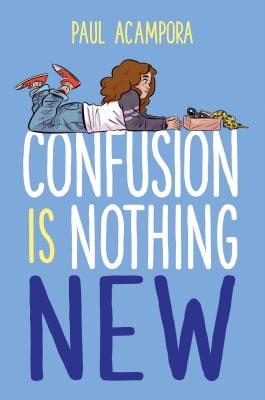craft review by Becky Levine
 Before I read Paul Acampora’s Confusion is Nothing New, my favorite of his books was How to Avoid Extinction. It’s now a toss-up which of the two sits at the top of my list. Confusion is Nothing New is brilliant in so many ways. For today, though, I’m going to focus on the way Acampora uses dialogue.
Before I read Paul Acampora’s Confusion is Nothing New, my favorite of his books was How to Avoid Extinction. It’s now a toss-up which of the two sits at the top of my list. Confusion is Nothing New is brilliant in so many ways. For today, though, I’m going to focus on the way Acampora uses dialogue.
We hear all the time how important dialogue is to writing, how it reveals character, creates voice, and builds and/or loosens the tension of a scene. But it’s one of those things that, for me anyway, is hard to pull apart from the rest of the story—hard to identify what is making it work or not work. Maybe because dialogue accounts for a very large percentage of the words in Acampora’s books, it’s a little easier for me to think about what he’s doing and why/how it works.
Let’s start with a sample. In the following scene, Ellie and her friend Daniel are in marching band and, due to circumstances not quite beyond their control, the band finds themselves in need of a new teacher. Sister Stephanie, the school principal, hires her brother for the job. One of the boys in the class recognizes him.
Sinbad glances back and forth between our principal and her brother. “Wait a minute,” he says out loud. “You’re Billy Leary?”
“I am Billy Leary,” the new teacher confirms.
“THE Billy Leary?”
“How many are there?” asks Charlotte. She turns to our new teacher. “Are you somebody?”
“You guys,” Sinbad says to the class, “this is Billy Leary.”
There is no reaction.
Mr. Leary turns to his sister. “Is this the abundance of respect you were talking about?”
“He was a big rock and roll star,” Sinbad explains.
“I don’t know if I’d go that far,” says Sister Stephanie.
“Hey,” Mr. Leary tells his sister, “don’t interrupt the boy.” Suddenly our class finds this man who needs a haircut and looks as if he might sleep in his clothes a lot more interesting.
“My dad has one of your albums,” Sinbad tells him.
Billy Leary gives him a smile. “You are officially my favorite student.”
“We found it at a yard sale,” Sinbad continues. “They were asking for a dollar, but he got it for fifty cents.”
“The position of favorite students is available once more.” Billy Leary announces to the class.
What’s happening here? I see a few things:
- Acampora uses an absolute minimum of dialogue attributions. Anywhere he can, he omits even the basic “he says” or “she says.” He often replaces “says” with a different word–“continues” or “announces.” Or he replaces it with a very brief action. Each time he does this, his choice weaves in the tiniest bit of stage direction–letting the reader see clearly what’s happening, without having to break away from the dialogue to read narrative description.
- His characters speak one, maybe two, sentences at a time. They keep their sentences short. This structure (and the sparseness of his attributions and descriptions) moves the dialogue along at a fast, snappy pace.
- The dialogue is real. Okay, it’s real in the way of those few seconds of perfect speech we regular mortals achieve once in a great while, but it feels real. You all know a Charlotte who jumps instantly onto anything potentially interesting. You all know a Sinbad who has that depth of knowledge about one particular subject and who—oh, yes—knows how to set up the perfect punch line and then deliver it with a…punch. And you all know (or maybe you are) the sister who is not going to let her brother’s head get any more swollen, not if she has anything to say about it.
- The dialogue goes up, and then it goes down. Sinbad’s ‘’THE Billy Leary” is followed by Charlotte’s “Are you somebody?” Sinbad tells the class that Billy was a big rock star, and Sister Stephanie pulls the rug out from under the compliment. Sinbad’s father has one of Billy’s albums, but he only paid 50 cents for it at a yard sale. Up, down. Up, down. Not with a potentially irritating rapid-fire, just fast enough that the humor hits you a split-second before you see it coming. And you laugh out loud.
- And what you can’t see in this single example is how Acampora uses dialogue to carry and deepen his humor throughout the story. He will drop a light version of a joke early on, then circle back to it a few chapters later, and then again further down the story road—always in dialogue. He doesn’t just repeat, though; he builds on what he’s done before. So it’s not just funny, it’s familiar and comfortable and funnier. Sinbad’s knowledge about musicians and bands comes up at several places in the book. Each time we read it, we laugh, and each time we read it, we see the relationship between him and Mr. Leary deepen.
Acampora does include action—check out the first chapter to see how Ellie stops a teacher from bullying Daniel. And he uses internal thought. The main plot of the story revolves around Ellie’s finding out her mother has died—the mother she has never met, spoken to, or heard anything about. And she has plenty of quiet scenes in which she is alone, thinking through the feelings she’s having and making choices about how she wants to act on them. For me, though, it is Acampora’s dialogue that stands out on every page, a power tool that he wields with skill and finesse. And it’s his dialogue that, for writers, is worth a second…and third…look.
Actions:
- Examine a section of dialogue in your Work In Progress.
- Try shortening or eliminating dialogue tags.
- Keep each piece of dialogue to one or two sentences to quicken the pacing.
- Look at each piece of dialogue to see if it accurately shows readers the character who’s speaking.
- Try out an “up-down” structure where one piece of dialogue undercuts the one before it.
- Read Confusion is Nothing New and analyze the way Acampora uses repetition in dialogue for humor.
After years of reading long Victorian novels, Becky Levine worked in closed-captioning, where they basically paid her to get rid of words. Somehow, that early mash-up of story and editing led to the picture-books she writes today. Becky is the author of two books for Capstone Press and is a member of SCBWI. She lives in California’s Santa Cruz mountains and works as Grants Manager for a regional nonprofit. In her free time, Becky travels with her husband in their Vanagon, including frequent road-trips to visit their son, and knits very simple baby blankets.

COMMENTs:
0